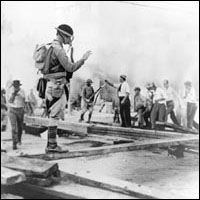 |

正在將一次世界大戰的退伍軍人自他們位於賓州大道上的露營地驅離的士兵
華盛頓特區 (Washington, D.C.) 1932年

|
 |
|
 |
巴頓及1932年的「酬恤金進軍事件」 (Bonus
March)
最先抵達華盛頓特區的聯邦政府官員之一即為巴頓上校。他的裝甲部隊在白宮附近的橢圓草坪與步兵團會合。巴頓及佩有瓦斯面罩、刺刀及軍刀的聯邦隊伍沿著賓州大道前行,以丟擲催淚手榴彈來進攻及鎮壓憤怒的民眾 。當晚稍後,巴頓及聯邦軍隊開始清除安那柯斯提(Anacostia)區域內的請願者帳篷,有些帳棚及簡陋木屋在清除的過程中甚至起火燃燒 。到了第二天早上,大部分的請願者都已經離開華盛頓特區,但這件事所留下的痛苦回憶卻深深的影響了巴頓。他稱此事為「最令人反感的任務」,並在後來幾篇文章中談論聯邦軍隊可以如何在造成最少流血傷亡的情況下,快速的恢復秩序。
One of the first federal officers to arrive in Washington, D.C., was Major George S. Patton. His cavalry troops met up with infantry at the Ellipse, near the White House. Patton and the federal troops, equipped with gas masks, bayonets and sabers, marched up Pennsylvania Avenue, firing gas grenades and charging and subduing the angry crowd. Later that night, Patton and the federal troops cleared out the marchers' camp in Anacostia, with some tents and shacks catching fire in the process. By the following morning, most marchers had left Washington, but the incident left bitter memories and affected Patton deeply. He called it the "most distasteful form of service" and later wrote several papers on how federal troops could restore order quickly with the least possible bloodshed.

 3 / 3
3 / 3

|





